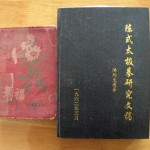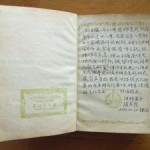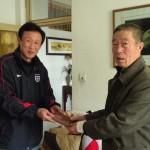Tai chi, the Chinese martial art involving slow and rhythmic movement, has been shown to benefit older people by maintaining balance and strength. Now, researchers have found that tai chi also helps patients who suffer from Parkinson’s disease. Read more
Knowledge : Articles
 Quality and quantity are two issues that come up a lot during training and seem to be the cause of some debate amongst practitioners. Generally most people have strong opinions about these two ideals and normally have specific training habits which clearly show which catergory they fall into. Read more
Quality and quantity are two issues that come up a lot during training and seem to be the cause of some debate amongst practitioners. Generally most people have strong opinions about these two ideals and normally have specific training habits which clearly show which catergory they fall into. Read more
Thanks to 鸣谢:
- Kelvin Ho 何家伟 http://ktaiji.blogspot.com/
- Frank Ding 丁建平 http://www.dynamictaichi.blogspot.com/
- All who attended the open house in Toronto.
**This is a short piece I wrote in the mid-90s about a way to define martial arts ** The martial arts are systems of combat developed for the purpose of either offense, defense or mass combat. However, these arts also have many goals beyond combative ones. There are countless reasons to decide to study the martial arts.
有道是“学拳容易改拳难”,与其学错了再改,不如一上手就学对的。练太极,尤其是在初期,要把自己的非太极动作改掉,改就是提高。 Read more
 When the body becomes accustomed to moving through the forms in a connected way, the structure of the body will naturally begin to tighten up. As a result, the over exaggerated stretching movements previously used to open up and recondition the body should be adjusted and made smaller and tighter. Read more
When the body becomes accustomed to moving through the forms in a connected way, the structure of the body will naturally begin to tighten up. As a result, the over exaggerated stretching movements previously used to open up and recondition the body should be adjusted and made smaller and tighter. Read more
 Standing atop a mountain in China’s Shandong province, Tai Chi master SENSEI SANDEEP DESAI finds himself.
Standing atop a mountain in China’s Shandong province, Tai Chi master SENSEI SANDEEP DESAI finds himself.
When my trip to Daqingshan, a mountain in the Shandong province of China came through, I was delirious with joy. It not only gave me an opportunity to further my development in the art but also fulfilled my ultimate fantasy to dissolve into T’ai Chi while experiencing the fresh chi of the mountain. I was seized by an overwhelming urge to realise my full potential while soaking in tranquility and serenity. Read more
 It is a fact that most modern people, especially westerners living in urbanized areas, are not as physically active as they once were. As society becomes more dependent on machines and electric tools to do the physical labour once done manually, the bodies of modern men seem to be changing accordingly. Read more
It is a fact that most modern people, especially westerners living in urbanized areas, are not as physically active as they once were. As society becomes more dependent on machines and electric tools to do the physical labour once done manually, the bodies of modern men seem to be changing accordingly. Read more
 Eventually, higher level students of Taijiquan come realize that the power produced in practice should never be produced by the muscles. But if it isn’t produced in the muscles, where does the incredible strength, flexibility and speed of the great masters come from? I believe this question can be answered by understanding the amazing system of tendons and ligaments which connects the muscular and skeletal structures. Although many people like to believe that “qi”
Eventually, higher level students of Taijiquan come realize that the power produced in practice should never be produced by the muscles. But if it isn’t produced in the muscles, where does the incredible strength, flexibility and speed of the great masters come from? I believe this question can be answered by understanding the amazing system of tendons and ligaments which connects the muscular and skeletal structures. Although many people like to believe that “qi”
The Master once said, “Everybody in the world uses momentum-based movement, therefore we do not. Taiji involves ‘contained spiral force’ that generates momentum on something external to oneself.”
 It seems to me that most people are not aware of the spiraling that should occur throughout the body while doing Taijiquan. Even though most people must have seen the ancient diagrams of a body coiled in lines representing the spiraling paths of the silk reeling energy (chansijin) characteristic of Chen style Taijiquan, very few people seem to be able to explain or even understand what this principle actually is. Obviously, it is not only important to know how to create spiraling throughout the body, but also to understand why spiraling and the unique energy it creates is so important to the art.
It seems to me that most people are not aware of the spiraling that should occur throughout the body while doing Taijiquan. Even though most people must have seen the ancient diagrams of a body coiled in lines representing the spiraling paths of the silk reeling energy (chansijin) characteristic of Chen style Taijiquan, very few people seem to be able to explain or even understand what this principle actually is. Obviously, it is not only important to know how to create spiraling throughout the body, but also to understand why spiraling and the unique energy it creates is so important to the art.
John Brown’s article Rotation: Approaching the impossible with the Practical Method was published by Kung Fu and Tai Chi Magazine in the Feb. 2012 issue. Here is a preview in jpg form. To read the entire article please purchase the magazine directly at www.kungfumagazine.com. Read more
太極拳,纏法也。纏法如螺絲形運於肌膚之上, Read more
“虛領頂勁“ is one of many Tai Chi principles. 虛 means void, which really has misled many people.
Interview with Chen Stylist Chen Zhonghua Read more
Chen Style Taijiquan Practical Method pays a great deal of attention to the lines on the human body. No matter in the performance of the routines, or in push hands, the body will naturally form energy lines. Some lines are formed quite naturally while others are formed gradually only after specialized training.
“实用”拳法之我见
李信明
陈中华老师在2011年7月 首期大青山国内实用拳法培训班上,幽默地讲了一个小故事,大意是有个老猎人用了一辈子猎棒,技艺精熟,每次上山打猎都收获不少。有一天有人向他推荐新式的 火枪,并演示了用法和效果; Read more
Hunyuan World 2004 gave participants access to an enormous wealth of essential knowledge on taijiquan. One of these gems of information relates to peng, a topic of great interest to camp participants. As an example of the teaching available at Hunyuan World events, I share Master Chen Zhonghua’s response to students’ questions on peng, which also led to more general comments on his interpretation of taiji. Read more
 (translated by Michael Koh of Singapore)
(translated by Michael Koh of Singapore)
TaiJi Quan is a special and unique martial art from China. Similar to Chinese calligraphy, classics culture and Traditional Chinese Medicine, she is both profound and captivating. Causes many practitioners to train night and day, laboriously and diligently. However, the number of people who has mastered this art is like stars at dawn, far and few. My story of my Taiji journey is divided to before and after I come to know Master Chen Zhong Hua. This is my brief testimony as a show of gratitude (to Master Chen).
为追思恩师而作
杨喜寿 Read more
 I started learning the Practical Method from video in February of this year (2011). Because I had studied Chen Style Taijiquan since 2006 and did not have a Practical Method teacher in my area, I thought I could learn from the wealth of information and videos available on the Practical Method website.
I started learning the Practical Method from video in February of this year (2011). Because I had studied Chen Style Taijiquan since 2006 and did not have a Practical Method teacher in my area, I thought I could learn from the wealth of information and videos available on the Practical Method website.
My first videos were the Basic Foundations and Yilu (First Routine) Detailed Instructions. I have since bought the Energy Alignment videos and various Mini Lessons. I also recommend Yilu Corrections.
Read more
 One concept which seems to come up in almost every lesson and principle Master Chen teaches is connection. But what does “being connected” actually mean? How do we achieve it and what are the benefits of being connected? I think these are all important questions that any serious Chen Style Taijichuan Practical Method student needs to explore and understand in order to gain a deeper understanding of this complex art. While most practioners seem to focus on the external choreography of the art, which is the first step and the foundation of the Yilu, I think the answer to what connection is can only be found by focusing on what happens inside the body. Taiji is, after all, an internal martial art!
One concept which seems to come up in almost every lesson and principle Master Chen teaches is connection. But what does “being connected” actually mean? How do we achieve it and what are the benefits of being connected? I think these are all important questions that any serious Chen Style Taijichuan Practical Method student needs to explore and understand in order to gain a deeper understanding of this complex art. While most practioners seem to focus on the external choreography of the art, which is the first step and the foundation of the Yilu, I think the answer to what connection is can only be found by focusing on what happens inside the body. Taiji is, after all, an internal martial art!
Hi, just some thoughts here i actually wanted to post on the specific category, but that is not possible anymore. It deals with shoulder and Kua and the connections between the trigrams. Read more
Excellent Article. It serves as a good reminder. Please be patient. It is being translated into English.
太极拳名家洪均生先生是太极宗师陈发科的入门弟子,一生致力于太极拳的研究,其功底深厚、松园缠 绵、缜密雄浑,在国内外影响很大,我成为师爷的再传弟于,实为三生有幸。 Read more
“太极拳,缠法也。”陈鑫这一句话把太极拳的缠绕的重要性普遍性说到位了。陈、
杨、吴、武、孙各家的螺旋缠绕含露有别,而以陈式太极拳表现得最为明显。陈式太极拳
实用拳法对于缠法有独到的研究和见解。 Read more
以我们普通人的思维,很难想像,一个身高一米六左右,自幼体弱多病的人,一个前半生富足,后半辈子穷困交加、大起大落的人,会静心于武学研究,会几十年如一日的坚持不变自己的信念;生活无情的给了他那么多挫折,他却以创立一派武学作为回馈!这是怎样的精神风范与意志? Read more
Though Taijiquan belongs to the realm of traditional sport, it is a perfect art form with precise theory and complex methodology. It is also a suitable method for people’s health. Students of this art should follow the rules strictly and go for the difficulties. They should carefully seek the regularities. In doing so, the first requirement is “solemn.” Read more
Master Chen happened to be in the studio while I was taking a break from doing yilu. I had done thirty forms that day, and I had in mind to do ten more in the hour left of class. Naturally, I was looking around for distractions before continuing. Read more
Hey Master Chen,
I would have posted this question on your website but it doesn’t seem to be working for me.
This is an obsevation and idea on moving and a question on if it sounds right. Read more

 I have been practicing Cheng Man Ching 37 style for 2 years, and in 2010 Apr, I started learning Chen Style Taiji in Singapore. After 3 months, I walked away feeling frustrated as I realized that what I learnt was “flower punch”. Nothing more than moving and waving my hands in the air. I didn’t give up and searched further on the internet brought me to a direct lineage from one of the master from Chen Village. I told myself, this teacher cannot be wrong. I signed up a 3 months course.
I have been practicing Cheng Man Ching 37 style for 2 years, and in 2010 Apr, I started learning Chen Style Taiji in Singapore. After 3 months, I walked away feeling frustrated as I realized that what I learnt was “flower punch”. Nothing more than moving and waving my hands in the air. I didn’t give up and searched further on the internet brought me to a direct lineage from one of the master from Chen Village. I told myself, this teacher cannot be wrong. I signed up a 3 months course. 




